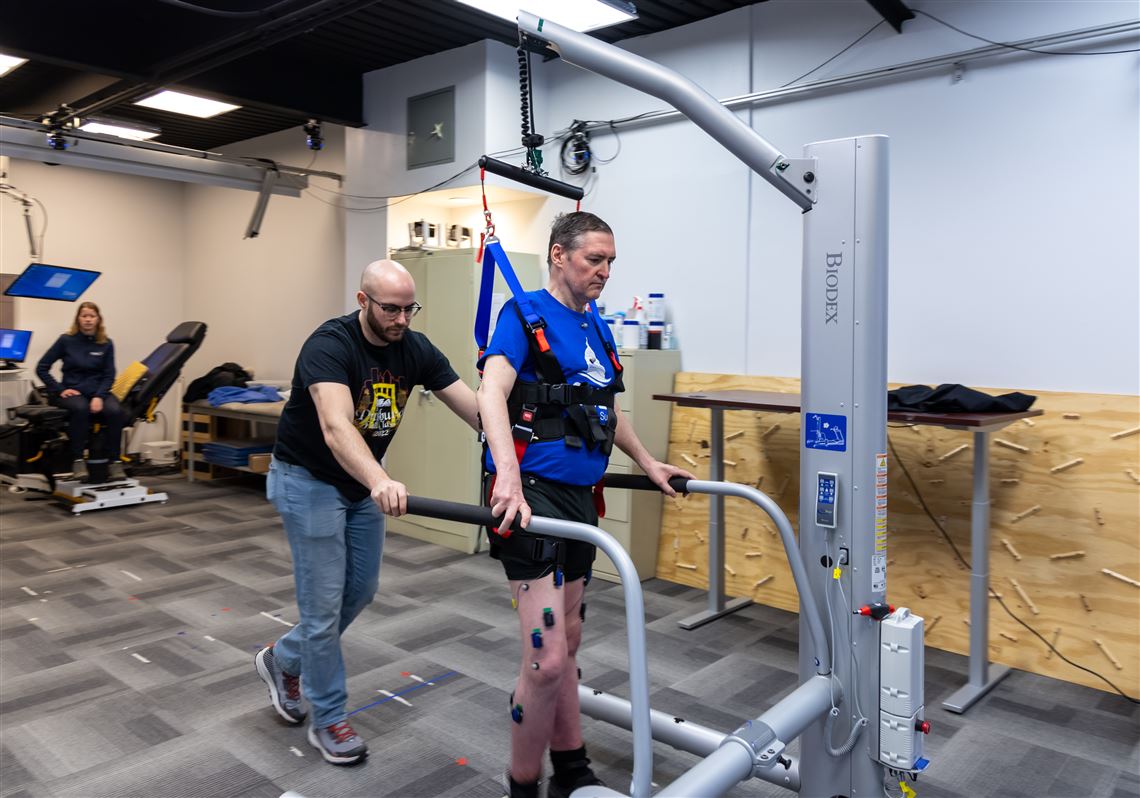When Doug McCullough was 11, he was the slowest runner in his class in Newville, Pa. It wasn’t just that he was slow, but his teachers noticed his gait was awkward too.
McCullough began visiting doctors, who, in 1979, couldn’t use genetic testing, and couldn’t settle on what was ailing him. It wasn’t until he was 17 that McCullough was diagnosed with Type 3 spinal muscular atrophy, or SMA.
Despite maintaining a fairly normal life — he went to college, received a master’s degree and worked at Johnson & Johnson for two decades — as McCullough got older, he faced increasing struggles with his mobility. It was harder for him to get up out of a chair and common for him to fall. In 2018, he started using a cane and, in 2021, a wheelchair, after multiple fall-related fractures.
This was around the time he ran into George Mentis in an elevator at an SMA conference. Mentis is a neurology professor at Columbia University, specializing in SMA research, whose earlier work in mice with SMA suggested that stimulating motor neurons in the spinal cord could improve the neurons’ function.
At the encouragement of Mentis, McCullough later became one of three patients to undergo the first human trial using a spinal cord stimulation technique for SMA patients, led by Pitt researcher Marco Capogrosso, an assistant professor at Pitt School of Medicine’s neurological surgery department and director of the Spinal Cord Stimulation Laboratory there.
The resultant study found that receiving the stimulation technique two hours a day for a month improved patients’ gait and their ability to walk and conduct motor tasks, and it increased their strength even after the stimulation was turned off. McCullough said that after a few hours of the trial, his legs felt “supercharged.”
The paper was published in Nature Medicine on Feb. 5.
“I didn’t even know this was possible,” said Capogrosso. “We weren’t expecting to see such strong results.”
The spinal cord device made by Medtronic, has been used before on stroke patients and is already clinically approved for pain, but it’s the first time it has successfully been used in patients with SMA.
“While [drug] therapies have transformed the disease course of SMA, there is still a significant unmet need, particularly in older patients who were not treated early enough,” said Karen Chen, CEO of the SMA Foundation, which helped fund the study, in an email statement.
“We were excited to see the impressive and persistent increases in motor function in SMA patients after only four weeks of spinal cord stimulation. Patients were not just stabilized by the treatment, but demonstrated improvements in muscle strength and endurance.”
SMA afflicts about 1 in 10,000 babies and occurs when a baby is born with mutations in the survival motor neuron, or SMN1 gene. This gene helps the body make motor proteins, aiding muscles in communicating with nerves so the muscles can reflex and contract, and the body can move. Without the protein, the muscles waste away.
The neuromuscular disease is the leading cause of infant mortality, and adults with severe SMA often die early from respiratory failure.
In the past decade, three groundbreaking drug treatments have been created to treat SMA. Helping patients to fend off the disease’s more severe complications are Spinraza (nusinersen), a quarterly injection by Biogen and Ionis; Evrysdi (risdiplam), a daily oral medication by Genentech; and Zolgensma (onasemnogene abeparvovec-xioi), a one-time infusion for babies and toddlers by Novartis.
These treatments boost production of the SMN proteins in the body to stop muscle wasting. It’s long been thought that using a mechanical approach — in other words, stimulating the motor neurons in the spinal cord directly — was futile, as they were already dead.
“These drugs do not target the circuit dysfunction,” said Capogrosso. “They target the cells.”
But Mentis’ research suggested otherwise. In a 2017 study, he showed that motor neuron impairment in mice with SMA could be rescued by treating them with kainate, an amino acid that excites certain channels in the brain and spinal cord.
Mentis and colleagues suggested in the paper that motor neuron dysfunction and motor neuron death were not the same thing — and that some quiet circuits in mice with SMA may just be dormant, not dead.
“I think of it as your body is like a house with faulty wiring, because it has a motor neuron disease,” said McCullough. “Maybe we can fix the wiring in your body, just like we’d fix it in a house.”
This got Capogrosso thinking about how he might help humans with SMA. He said Genentech approached him with an approximately $2.5 million grant and a request to collaborate in the study (along with the SMA Foundation).
The trial, which started in September 2022, involved a surgery, in which Peter Gerszten, a professor of neurological surgery at Pitt, implanted small electrodes near patients’ spinal cords, in the lower lumbar area.
McCullough joked that he felt like they were connecting him to a car battery. Based in New Brunswick, N.J., he travelled to and stayed in Pittsburgh for the length of the trial. (He enjoyed seeing a Penguins game with VIP seats.)
All three participants in the trial were men; McCullough was 55 at the time of the experiment, and the others were 22 and 30.
McCullough and the others were examined in a battery of motor tests that helped researchers understand whether muscle-to-nerve communication was improving. With sensors down their legs, participants bent and extended their limbs to measure knee torque and flexion. They walked in the “gait laboratory” and had their joint angles measured, to see whether gait improved, as well as strength. Researchers also measured the firing rate of their motor neurons.
Capogrosso was surprised to see that the participants showed improvement in all the same variables, displaying an unexpected consistency in the results.
“It’s really surreal to have any improvement with a progressive disease,” said McCullough. “Seeing any improvement was really exciting.”
With just three participants, it’s a small, proof-of-concept study. Capogrosso already has plans to see if the technique could work for people with Types 1 and 2 SMA, or if the stimulation device could be implanted longer term.
“How will these changes translate to the daily living of a patient?” he asked. “Will it work with assisted devices?”
McCullough said it’s important for him to remain active and to maintain independence with his quality of life: “This is a use it or lose it disease.”
He’s taken Spinraza since 2018 but says he hasn’t noticed much improvement from the drug. The spinal cord stimulation, by contrast, made him think he might be able to walk a mile.
All participants returned to Pittsburgh six weeks after the trial for a follow-up. McCullough said he noticed residual improvements from the stimulation at that time, but at a six-month follow-up, any signs of improvement from the trial were gone, and he was regressing at his normal pace again.
Karen Chen said her team at the SMA Foundation thinks spinal cord stimulation holds promise for SMA patients and could address remaining needs for older patients.
“This changes the game,” said Capogrosso. “It opens up a whole new set of applications. How many other diseases can we target with a similar approach?”
First Published: February 15, 2025, 10:30 a.m.
Updated: February 17, 2025, 2:10 p.m.
















